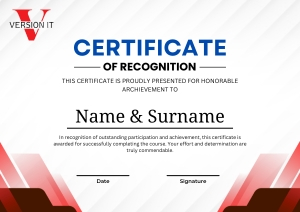Home > Courses > Full Stack Courses > Dot Net Full Stack > SQL Server Administration Course
SQL Sеrvеr Administration
SQL Server Training in Hyderabad is in high demand in the market, and this demand for this course has been continuing for the past decade. A SQL Sеrvеr training course is a well-structured educational program dеsignеd to еquip individuals with thе knowledge and skills necessary to effectively work with Microsoft SQL Sеrvеr, a relational database managеmеnt systеm (RDBMS).
17 Modules
with Certifications
Certificate
After Completion
English
Language
As in any business sector, keeping up with the changing technological terrain calls for some necessary skills. Version IT knows that it is necessary to give people information that will help them to use it, that’s why, our SQL Server training in Hyderabad is a shining light for those who are going to learn SQL Server nowadays.
SQL Server Training in Hyderabad
Join us for a revolutionary ride to learn our all-around SQL Server training in Hyderabad. One of the strongest relational database management systems created by the company, which plays a key role in data management is the SQL Server. The curriculum of our course is carefully designed to ensure that you grasp the fundamentals of SQL Server that will allow you to maximize its benefits.
Course Features
A detailed syllabus of the SQL server training in Hyderabad incorporates topics on database architecture, SQL programming, query optimization, and advanced queries. It is open to novices as well as experts, who will benefit from exercises and live case studies. The professors of this course are experienced professionals who ensure that students understand not only theoretical concepts but also can relate them to practical problems in real database administration.
Outcomes
After accomplishing SQL Server training in Hyderabad, you will understand database structures and how best to design and maintain powerful databases. It will make you a versatile SQL programmer with competency in writing complex queries with high-level optimizations for database efficiency. Our industry-specific curriculum prepares you for what is required of a prospective information technology career.
Why select version it as your SQL server course institution in Hyderabad?
One of the best SQL Server training institutions in this city is Version IT which offers high-class academic work and hands-on knowledge. Skill development and innovations are the founders of our developed facilities and faculties.
Transform your IT systems by visiting Version IT, the number one provider of SQL server training in Hyderabad. Boost your job opportunities and learn to be a competent SQL Server expert with our relevant and specialized training curriculum.
Topics You will Learn
Introduction To DBMS
- File Management System And Its Drawbacks
- Database Management System (DBMS) and Data Models
- Physical Data Models
- Logical Data Models
- Hierarchical Data Model (HDBMS)
- Network Data Model (NDBMS)
- Relational Data Model (RDBMS)
- Object Data Model (ODBMS)
- Object Relational Data Model (ORDBMS)
- Conceptual Data Models
- Entity – Relationship (E-R) Model
Introduction To SQL Server
- Advantages and Drawbacks Of SQL Server Compared To Oracle And DB2
- Connecting To Server
- Server Type
- Server Name
- Authentication Modes
- Sql Server Authentication Mode
- Windows Authentication Mode
- Login and Password
- Sql Server Management Studio and Tools In Management Studio
- Object Explorer
- Object Explorer Details
- Query Editor
TSQL (Transact-Structured Query Language) Introduction To TSQL
- History and Features of TSQL
- Types Of TSQL Commands
- Data Definition Language (DDL)
- Data Manipulation Language (DML)
- Data Query Language (DQL)
- Data Control Language (DCL)
- Transaction Control Language (TCL)
- Database
- Creating Database
- Altering Database
- Deleting Database
- Constrains
- Procedural Integrity Constraints
- Declarative Integrity Constraints
- Not Null, Unique, Default and Check constraints
- Primary Key and Referential Integrity or foreign key constraints
- Data Types In TSQL
- Table
- Creating Table
- Altering Table
- Deleting Table
Data Manipulation Language
- Insert
- Identity
- Creating A Table From Another Table
- Inserting Rows From One Table To Another
- Update
- Computed Columns
- Delete
- Truncate
- Differences Between Delete and Truncate
Data Query Language (DQL)
- Select
- Where clause
- Order By Clause
- Distinct Keyword
- Isnull() function
- Column aliases
- Predicates
- Between … And
- In
- Like
- Is Null
Built In Functions
- Scalar Functions
- Numeric Functions
- Character Functions
- Conversion Functions
- Date Functions
- Aggregate Functions
- Convenient Aggregate Functions
- Statistical Aggregate Functions
- Group By and Having Clauses
- Super Aggregates
- Over(partition by …)Clause
- Ranking Functions
- Common Table Expressions (CTE)
Top n Clause Set Operators
- Union
- Intersect
- Except
Joins
- Inner Join
- Equi Join
- Natural Join
- Non-Equi Join
- Self Join
- Outer Join
- Left Outer Join
- Right Outer Join
- Full Outer Join
- Cross Join
Sub Queries
- Single Row SubQueries
- Multi Row Sub Queries
- Any or Some
- ALL
- Nested Sub Queries
- Co-Related Sub Queries
- Exists and Not Exists
Indexes
- Clustered Index
- NonClustered Index
- Create , Alter and Drop
- Indexes
- Using Indexes
Security
- Login Creation
- SQL Server Authenticated Login
- Windows Authenticated Login
- User Creation
- Granting Permissions
- Revoking Permissions
- Roles
Views
- Purpose Of Views
- Creating , Altering and Dropping Indexes
- Simple and Complex Views
- Encryption and Schema Binding Options in creating views
Transaction Management
- Introduction
- Begin Transaction
- Commit Transaction
- Rollback Transaction
- Save Transaction
- Role Of Log File In Transaction Management
- Implicit Transactions
TSQL Programming
- Drawbacks Of TSQL that leads to TSQL Programming
- Introduction To TSQL Programming
- Control statements In TSQL Programming
- Conditional Control Statements
- If
- Case
- Looping Control Statements
- While
Cursors
- Working With Cursors
- Types Of Cursors
- Forward_Only and Scroll Cursors
- Static, Dynamic and Keyset Cursors
- Local and Global Cursors
Stored Sub Programs
- Advantages Of Stored Sub Programs compared to Independent SQL
- Statements
Stored Procedures - Creating , Altering and Dropping
- Optional Parameters
Input and Output Parameters - Permissions on Stored Procedures
- User Defined Functions
- Creating, Altering and Dropping
- Types Of User Defined Functions
- Scalar Functions
- Table Valued Functions
- Inline Table Valued Functions
- Multi Statement Table Valued Functions
- Permissions On User Defined Functions
- Triggers
- Purpose of Triggers
- Differences Between Stored Procedures and User Defined Functions and Triggers
- Creating, Altering and Dropping Triggers
- Magic Tables
- Instead Of Triggers
- Exception Handling
- Implementing Exception Handling
- Adding and removing User Defined Error Messages To And From SQL Server Error Messages List
- Raising Exceptions Manual
CLR Integration
- What is CLR Integration and The Steps For Implementing It
- A Simple Example With CLR Integration
Let Your Certificates Speak

- Extensive SQL Server training.
- Certifications improve your programming profile and are accepted across the world.
- Certificates are issued upon the course's conclusion.
All You Need to Start this Course
- Knowledge of the fundamental ideas of relational databases, including tables, rows, columns, foreign keys, primary keys, normalisation, and indexing.
- Since SQL is a query language, learning programming principles can help you better comprehend SQL concepts.
Testimonials




Still Having Doubts?
Microsoft's RDBMS system, SQL Server, is primarily used for storing and retrieving data in response to user requests. Although it is sometimes mislabeled as SQL, SQL Server is a Microsoft product that supports SQL, whereas SQL is a language.
Normalisation is the process of arranging data in RDBMSs to reduce redundancy and ensure logical data integrity. The process of normalisation involves splitting the database up into two or more tables and defining a relationship between them. The normalisation process improves the database's performance.
It is the process of adding duplicate data in an effort to maximise database performance. De-normalization is the purposeful introduction of redundancy into a table with the goal of enhancing performance. While there is some write speed decrease, the de-Normalization procedure improves read performance. The redundant form of a set of data can be created to do this. The de-normalized and un-normalized databases differ greatly from one another. Any database should be normalised before undergoing the de-normalization procedure.


